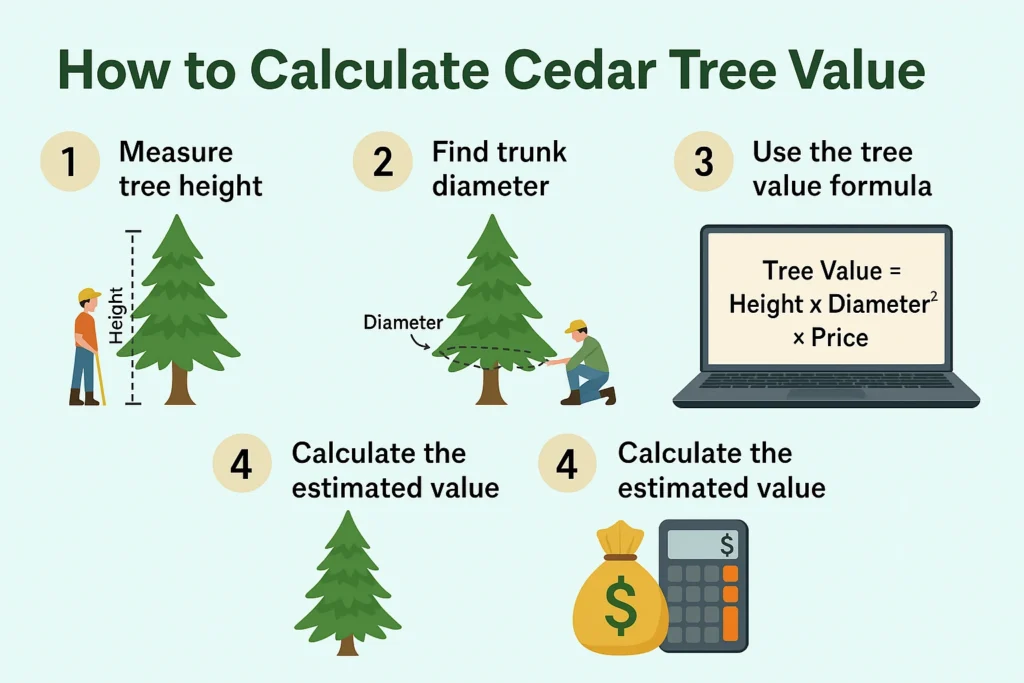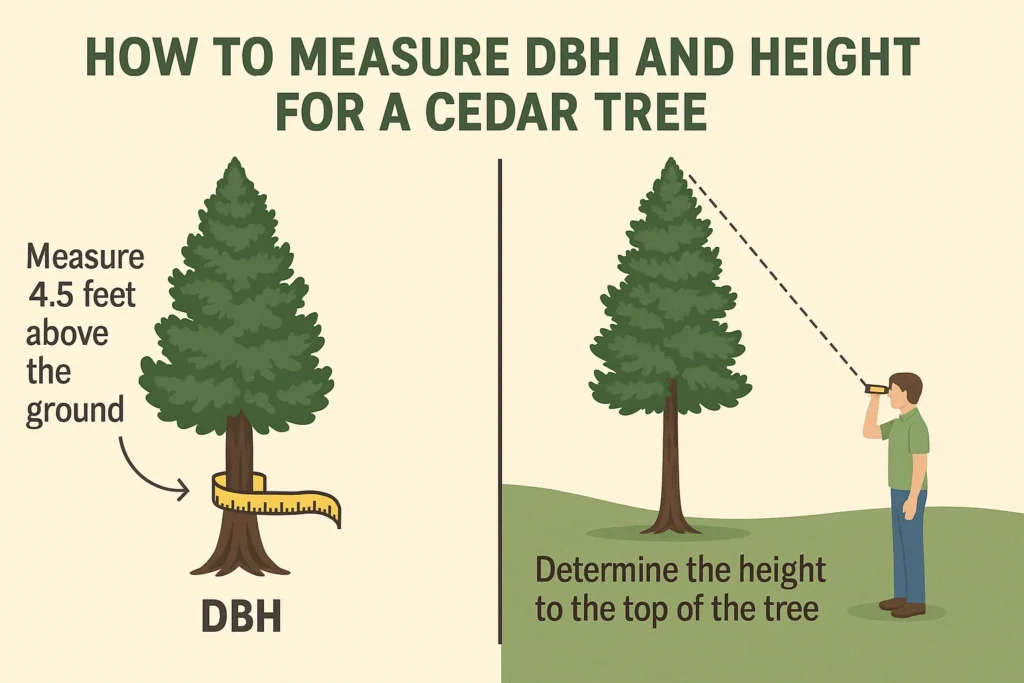🌲 Cedar Tree Value Calculator
Estimate the value of a cedar tree based on its size, stumpage price, and local market conditions.
What is the Local Market Factor?
This factor adjusts the final estimated value to account for local demand, accessibility, and other conditions.
- A value of 1.0 means no extra adjustment.
- A value of 1.2 (for example) increases the tree's estimated value by 20%.
- A value less than 1.0 would decrease the value accordingly.
In the calculation: Estimated Tree Value = Board Feet × Stumpage Price × Local Market Factor.
Cedar Tree Value Calculator

Created by James S. Lockwood
With a background in botany and ecological sciences, James specializes in creating practical tools and resources to help gardeners, farmers, and plant enthusiasts optimize their green spaces.
Cedar trees have long been admired for their durability, fragrance, and visual appeal. Whether standing tall in your backyard or nestled in a forested lot, you might find yourself wondering: How much is my cedar tree actually worth? A cedar tree value calculator can help break it down—but like most things in forestry, the answer depends on more than just one number.

Table of Contents
Understanding the True Value of a Cedar Tree
Cedar trees aren’t all created equal. Some species, like Eastern Red Cedar, are prized for their aromatic wood and resistance to decay. Others, like Western Red Cedar, are valued in construction and furniture-making for their workability and longevity. But how do you go from admiring a tree to putting a dollar value on it?
This is where a cedar tree value calculator becomes essential. It estimates a tree’s worth by combining measurable factors like diameter at breast height (DBH), total height, species-specific timber rates, condition, and even its location.
But here’s the thing: not every calculator considers cedar trees specifically. That’s why using a dedicated cedar tree value calculator—like the one available on PlantCalculators—is your best bet for a realistic appraisal.
How Cedar Tree Value Is Calculated?

Let’s break it down. The most common method involves calculating volume (based on DBH and height), then multiplying it by a species rating and adjusting for factors like tree condition and location. It’s a simplified version of the CTLA formula, which professional arborists use when valuing landscape trees.
CTLA Formula: Cedat Tree Value = Estimated Board Feet × Market Price per Board Foot
So while you can manually measure your tree’s DBH with a tape and use tools like our Tree Diameter Calculator or Tree Height Calculator, the actual value estimate still requires assumptions—like local market prices or decay condition—that can change year to year.
And this is where things get a bit subjective. A healthy cedar in an urban landscape might be worth more than a slightly larger one in the middle of a remote forest. Beauty, location, and demand all play a role in shaping the final figure.
Is Timber the Only Metric of Value?
Not at all. While timber value is the most tangible and easy to quantify—especially with a Tree Value Calculator or even a Pine Tree Value Calculator for comparisons—there are other layers of worth to consider. Trees also offer carbon sequestration, shade, privacy, and sometimes even historical or emotional significance.
Some homeowners, for instance, believe their cedar tree boosts property value simply by its presence and maturity. While there’s no standard formula for that kind of impact, tools like the Tree Carbon Sequestration Calculator can help if you’re emphasizing environmental benefits over market price.
If you’re working with multiple trees or need a better sense of physical density and potential yield, you might also want to measure basal area. It represents the cross-sectional area of the trunk and is widely used in forestry to estimate timber volume per acre. You can get this measurement instantly using the DBH to Basal Area Calculator—especially helpful when evaluating groves or comparing individual tree structures.
Still, when it comes to sales, insurance, or removal estimates, timber value remains the most universally accepted metric. It’s the one figure both buyers and appraisers are likely to understand—and negotiate around.
Common Cedar Tree Types and Their Value Potential
Not all cedar trees are equally marketable. Here’s a rough breakdown:
Eastern Red Cedar: Highly valued for fence posts, closets, and pest-resistant qualities. Moderate growth, excellent durability.
Western Red Cedar: Sought after in outdoor construction; fast-growing and typically fetches higher timber prices.
Northern White Cedar: Less dense, but often used in posts and rustic furniture. Lower timber value but easier to harvest.
So, if you’re using a cedar tree value calculator, it’s worth identifying your specific type. Even a few inches in DBH can lead to a significant price jump—especially if the species is in demand.
Age, Condition, and the "X Factor"
Age can be a tricky thing. While older trees are often more valuable due to size, decay or internal rot can cancel out the gain. If you’re unsure about your cedar’s age, consider trying the Tree Age Calculator, which uses DBH and growth rate to provide a ballpark estimate.
Condition also matters more than most assume. A cedar with disease, dead branches, or trunk damage could be devalued by 50% or more in a professional appraisal—even if it’s large and in a good location.
And then there’s the “X factor”—things like curb appeal, historic value, or scarcity. A homeowner might insist their cedar is worth $5,000 because it’s the oldest on the street. A timber buyer might disagree and offer $200.
Timber Prices by Cedar Type
| Grade | Price per Board Foot |
|---|---|
| Premium | $2.80 |
| Standard | $1.90 |
| Utility | $1.20 |
| Grade | Price per Board Foot |
|---|---|
| Premium | $3.10 |
| Standard | $2.35 |
| Utility | $1.60 |
| Grade | Price per Board Foot |
|---|---|
| Premium | $2.10 |
| Standard | $1.50 |
| Utility | $1.00 |
According to this forestry pricing guide by the USDA Forest Service, market value can vary widely based on species, condition, and region—reinforcing why tools like a cedar tree value calculator are just a starting point.
When to Use a Cedar Tree Value Calculator?
You should use a calculator when:
Preparing to sell timber
Getting insurance estimates
Planning landscaping or removal
Comparing to other tree types like oak, hickory, or black walnut using our Oak Tree Value Calculator or Black Walnut Tree Value Calculator
While the cedar tree value calculator offers a fast estimate, think of it as a conversation starter rather than a final verdict. The tool is only as good as the information you provide—and the assumptions you make.
Frequently Asked Questions
How do you calculate the value of a cedar tree?
To calculate cedar tree value, measure DBH and height, then adjust for species rating, condition, and location. Our calculator automates this using CTLA guidelines.
Are cedar trees valuable for timber?
Yes, especially Eastern Red Cedar and Western Red Cedar are valued for rot resistance and fragrance. Timber prices vary by quality and location.
Final Thoughts: What Is a Cedar Tree Really Worth?
There’s no universal answer. A mature cedar tree might be worth $150 in timber but $1,500 in landscaping value—or maybe it’s priceless to the homeowner who planted it with their grandfather.
That’s why the best approach is layered: start with a cedar tree value calculator, verify with a DBH measurement, factor in local timber prices, and—if necessary—consult a certified arborist.
If you’re just looking to get started, try our full suite of tools including the Tree Height Calculator, Tree Value Estimator, and Tree Removal Cost Calculator to round out your understanding.
Sometimes, value lies not just in the trunk and branches, but in the roots of how much that tree means to you.
Disclaimer
This calculator provides an estimate based on standard formulas and market trends. Actual values may vary based on location, timber quality, and local demand. For precise timber valuation, consult a certified forester or timber buyer.
Discover Tree & Forestry Calculators
